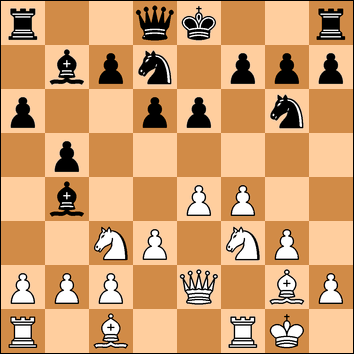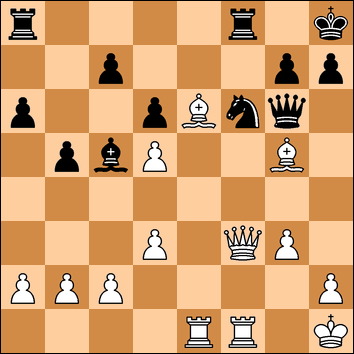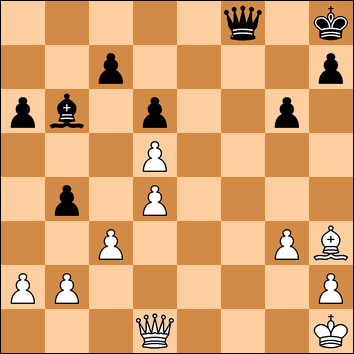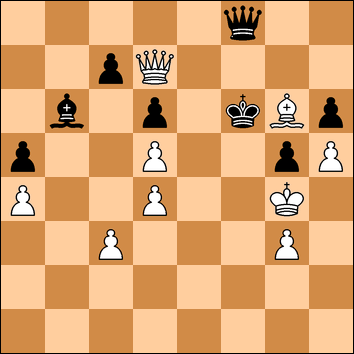Swale Club Chess Championship - Round Three
Thursday 27 September 2018
White: Keith Nevols (163) Black: Tyrone Jefferies (119)
French Defence
I entered this game in a low mood after the disappointment of the previous week.
1. e4 e6
1. e4 e6
2. Qe2
My standard anti-French. The idea is that if Black plays 2. .. d5 (as French players usually do) then after 3. exd5 he has to re-take with the queen. It is not dangerous for either side at all but often positions move into a closed Sicilian (after Black plays c5) which suits me.
2. .... a6
In this game, my opponent decides to play the St George's Defence, a system made famous by Tony Miles defeating the then world champion Anatoly Karpov in 1980.
3. Nc3 b5
My standard anti-French. The idea is that if Black plays 2. .. d5 (as French players usually do) then after 3. exd5 he has to re-take with the queen. It is not dangerous for either side at all but often positions move into a closed Sicilian (after Black plays c5) which suits me.
2. .... a6
In this game, my opponent decides to play the St George's Defence, a system made famous by Tony Miles defeating the then world champion Anatoly Karpov in 1980.
3. Nc3 b5
4. f4 Bb7
5. Nf3 Ne7
6. d3 Ng6?!
I think this is a strange place to put the knight - just asking for f5 at some point. Indeed I could play it now - 7. f5 exf5 8. exf5+ Ne7 9. Ne4 - but wanted to ensure my king was safe first and I had some pieces developed. Having a rook on f1 might be useful too.
I think this is a strange place to put the knight - just asking for f5 at some point. Indeed I could play it now - 7. f5 exf5 8. exf5+ Ne7 9. Ne4 - but wanted to ensure my king was safe first and I had some pieces developed. Having a rook on f1 might be useful too.
7. g3 Bb4
8. Bg2 d6
9. O-O Nd7

Castling on either of the last two moves would have been better for Black. Now I have the chance to create the initiative I mentioned earlier.
Castling on either of the last two moves would have been better for Black. Now I have the chance to create the initiative I mentioned earlier.
10. f5 Nge5
If 10... exf5 11. exf5+ Ne7 White could keep up the pressure with 12. Nd4 Bxg2 13. Kxg2 Ne5 14. Bg5 and Ne4.
If 10... exf5 11. exf5+ Ne7 White could keep up the pressure with 12. Nd4 Bxg2 13. Kxg2 Ne5 14. Bg5 and Ne4.
11. fxe6
After 11. ... fxe6 I was planning 12. Ng5. (12. Bg5?? loses to 12. .. Nxf3+)
11. ..... Nxf3+?
But this loses a pawn and weakens the Black kingside.
After 11. ... fxe6 I was planning 12. Ng5. (12. Bg5?? loses to 12. .. Nxf3+)
11. ..... Nxf3+?
But this loses a pawn and weakens the Black kingside.
12. Qxf3 Nf6
13. exf7+ Kxf7
I now had a big think to see if there was any way to build up on this. The computer's recommendation is 14. Be3 but I decided to pressure on f6.
14. Bg5 Rf8!
Good defence. Planning to castle artificially. I examined 15. Bxf6 gxf6 16. Qh5+ Kg8 but there is nothing there. The computer considers 15. d4 calmly improving to be best.
Instead I opt to force the exchange of a Black bishop while limiting the scope of the other one.
I now had a big think to see if there was any way to build up on this. The computer's recommendation is 14. Be3 but I decided to pressure on f6.
14. Bg5 Rf8!
Good defence. Planning to castle artificially. I examined 15. Bxf6 gxf6 16. Qh5+ Kg8 but there is nothing there. The computer considers 15. d4 calmly improving to be best.
Instead I opt to force the exchange of a Black bishop while limiting the scope of the other one.
15. Nd5 Bxd5
16. exd5 Bc5+
17. Kh1 Kg8
Black has solved the problem of his king but White has the two bishops and a beautiful square on e6 which one bishop now heads for.
Black has solved the problem of his king but White has the two bishops and a beautiful square on e6 which one bishop now heads for.
18. Bh3 Qe8
19. Rae1 Qg6
20. Be6+ Kh8
And now I draw a blank. Black has defended well and I need to do something with that g5 bishop. Learning from my mistake last week I decide to exchange some pieces off and try to outplay my opponent in the ending.
However 21. Bd2 is best here planning to relocate to c3. There are no useful discovered attacks from Black moving the knight on f6.

21. Bxf6?! Rxf6
And now I draw a blank. Black has defended well and I need to do something with that g5 bishop. Learning from my mistake last week I decide to exchange some pieces off and try to outplay my opponent in the ending.
However 21. Bd2 is best here planning to relocate to c3. There are no useful discovered attacks from Black moving the knight on f6.
21. Bxf6?! Rxf6
For some reason I only considered 21. .. Qxf6 where I planned 22. Qxf6 to isolate a black pawn on f6.
22. Qd1 Raf8
And now I thought I was in danger of losing the game, although there are no immediate threats. My mind was on how I could isolate the black bishop out of the game but here 23. d4 loses at once to 23. .. Rxf1+ 24. Rxf1 Qe4+.
And now I thought I was in danger of losing the game, although there are no immediate threats. My mind was on how I could isolate the black bishop out of the game but here 23. d4 loses at once to 23. .. Rxf1+ 24. Rxf1 Qe4+.
23. Rxf6 Qxf6
24. c3 Bb6
24. .. Bf2 was worth a thought. 25. Rf1 Qe7 26. Qe2 Be3!
24. .. Bf2 was worth a thought. 25. Rf1 Qe7 26. Qe2 Be3!
25. d4
Mission accomplished. Now if I can keep the bishop tied up over there then effectively I am a piece up.
25. ..... b4
Mission accomplished. Now if I can keep the bishop tied up over there then effectively I am a piece up.
25. ..... b4
26. Bh3
Planning more exchanges down the f-file.
26. ... g6
Planning more exchanges down the f-file.
26. ... g6
27. Rf1 Qe7
28. Rxf8 Qxf8

29. Qe2 bxc3
30. bxc3 a5?!
This surprised me. I had expected 30. .. Ba5. (31. Qxa6? would allow 31. .. Qf3+ and a chance for a draw).
This surprised me. I had expected 30. .. Ba5. (31. Qxa6? would allow 31. .. Qf3+ and a chance for a draw).
31. Kg2 Kg7
32. Be6 Qf6
33. a4
The bishop is shut in. So the plan .... advance on the kingside, tie Black down, exchange queens, exploit with the king. Easier said than done.
33. ... Kf8
The bishop is shut in. So the plan .... advance on the kingside, tie Black down, exchange queens, exploit with the king. Easier said than done.
33. ... Kf8
34. h4 h6
35. h5
35. Qe1 and g4-g5 might have been a better idea. As played, the Black pawns end up on Black squares and are not so easy for the bishop to attack.
35. ... g5
Black could have played 35. .. gxh5 36. Qxh5 c5 to try to free the bishop.
35. Qe1 and g4-g5 might have been a better idea. As played, the Black pawns end up on Black squares and are not so easy for the bishop to attack.
35. ... g5
Black could have played 35. .. gxh5 36. Qxh5 c5 to try to free the bishop.
36. Qf3 Kg7
37. Qe4
I did not like 37. Qxf6 Kxf6 - although the White king might be able to exploit through c4-b5.
37. ..... Ba7
37. Qe4
I did not like 37. Qxf6 Kxf6 - although the White king might be able to exploit through c4-b5.
37. ..... Ba7
38. Bg4 Bb6
39. Qe8 Qf7
40. Qe4
Change of mind. I decide to hold off the queen exchange until my king is further forward.
40. ... Ba7
Change of mind. I decide to hold off the queen exchange until my king is further forward.
40. ... Ba7
41. Bf5 Qf6
42. Kh3 Bb6
43. Kg4 Qf7
44. Bg6 Qf6
45. Qe8 Qf8
46. Qd7+ Kf6
Now down to the last five minutes I stopped writing down the moves.

I was not confident that exchanging queens would win - Black had enough to defend and stop the White king getting through. What I needed to do was force a queen exchange with my queen on e6 to change the pawn structure. This I managed to do - with bishop on f5, queen on e6 and the Black king on f6 and queen on e7 - forcing Qxe6; dxe6 and my pawn was on e6.
Black freed his bishop and White was able to infiltrate the king to the kingside and take the pawns on h6 and g7. Advancing the pawn to h7 kept the Black bishop occupied, the pawn on e6 kept the king busy, so that left the queenside.
I advanced my king over to the queenside, captured on a5, and advanced forcing the win of the bishop. With just the centre pawns left, I got the king to c7 where the d-pawn could be nursed home. This is when Black resigned.
Not an easy win but I was glad to get the full point.
Now down to the last five minutes I stopped writing down the moves.
I was not confident that exchanging queens would win - Black had enough to defend and stop the White king getting through. What I needed to do was force a queen exchange with my queen on e6 to change the pawn structure. This I managed to do - with bishop on f5, queen on e6 and the Black king on f6 and queen on e7 - forcing Qxe6; dxe6 and my pawn was on e6.
Black freed his bishop and White was able to infiltrate the king to the kingside and take the pawns on h6 and g7. Advancing the pawn to h7 kept the Black bishop occupied, the pawn on e6 kept the king busy, so that left the queenside.
I advanced my king over to the queenside, captured on a5, and advanced forcing the win of the bishop. With just the centre pawns left, I got the king to c7 where the d-pawn could be nursed home. This is when Black resigned.
Not an easy win but I was glad to get the full point.